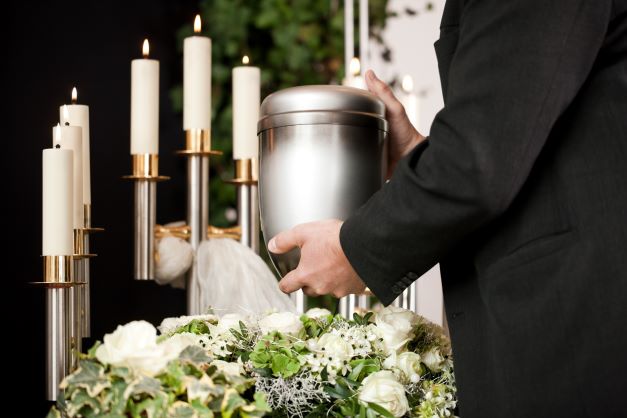All Articles & Guides / Ashes / Checklist for a Scattering Ashes Ceremony
Checklist for a Scattering Ashes Ceremony

After the death of a friend or loved one, many people find closure and relief in scattering ashes in a favorite place or memorable location. Once you’ve decided where you’d like to spread the ashes and make sure that it’s legal to do so, it’s a good idea to plan out the event before the day arrives. Scattering ashes ceremonies can include readings or poems, music, sharing memories, and releasing the cremains. Planning on how to scatter ashes, what to say when scattering ashes, who will release the ashes, and other little details will help the ceremony go smoothly.
Use this checklist to plan a scattering ashes ceremony for your loved one.
✔ Decide What Type of Service You'd Like
Since there are no firm requirement for what must be included in a spreading ashes ceremony, you really have the freedom to design your ceremony to best represent the personality and life of your loved one. Check out some of the common, and creative, ideas we have come across:
- Setting off Fireworks: The beautiful display is symbolic of life, lasting only for a moment but making an impact.
- Casting Ceremony: This is your typical ash scattering ceremony, one in which you let the wind take your loved one wherever it pleases.
- Airplane Release: Whether you wish to scatter the cremains yourself or prefer for a pilot to do the spreading (often a better option), airplane release is one of the best ways to disperse the deceased across his or her favorite area.
- Trenching the Ashes: A well-known practice, a trenching ash scattering service is when you dig a hole, or trench, to place your beloved’s ashes.
- Lanterns to Guide Them Home: Say goodbye to your loved one by releasing paper lanterns into the sky while scattering his or her ashes. The light represents the deceased finding their way to heaven. Be sure they are not a fire hazard and are biodegradable.
- Let the Water Take Them Away: Place the cremains in paper boats and place them in a stream or spread the ashes across the river. Then, allow the water to wash away your grief and carry your loved one to peace. Make sure your chosen waterway allows this sort of spreading ashes ceremony and be sure to use a biodegradable urn if you are planning on placing the whole urn in the water.
- Raking into the Soil: An environmentally-conscious idea, raking is when you spread the cremains and rake them into the ground where they lay, whether that is in a garden, the beach, or his or her favorite place.
- Tie in Symbolism with Nature: Some families choose to release a flock of doves to embody serenity and hopefulness. Others like to think of an ash scattering ceremony as a metamorphosis of the spirit or a transition in life, so they bring butterflies to the event.
- Set Them Free: Join the Eternal Ascent Society in sending your loved one high up into the sky at 30,000 feet in a helium-filled balloon. The high altitude will cause the balloon to chill and pop, which will set the cremains free.
✔ Choose Someone to Lead the Ceremony
Even if you’re planning a simple, informal ash scattering ceremony, it’s a good idea to have one person as the designated leader. You may choose to take on this role, if you’re planning the event, or ask someone else to lead. You can ask a family member, friend, or even a religious leader to help guide the ceremony.
The leader’s job is simple: to know what the plan is and to keep the event moving forward as expected. He or she may simply keep things on track or take a more active role, reading a poem or prayer, giving the eulogy, or being the one to scatter the ashes. Having someone who knows what comes next in your ceremony can help the ceremony run smoothly and avoid uncertainties.
✔ Determine the Order of Events
Once you’ve decided on the formality of the ash scattering ceremony and who will lead it, you need to determine what will happen during the event. Decide on what to say when scattering ashes through expressive ways like:
- Prayers or psalms
- Poems
- Music
- Quotes
- A eulogy
- Stories and memories
When choosing sayings, poems, and music, consider whether the deceased had favorites that might be appropriate for the occasion. If not, there are many general bereavement poems, songs, and prayers that can be very meaningful. Make sure that you have a copy of anything that will be read, including prayers and the eulogy, if one will be given.
Consider who will be invited to speak and advise them on what to say when scattering ashes. For a small gathering, there may be plenty of time for everyone to speak and share memories of the deceased. For more formal events, you might invite one or two people to speak, or only have the family share their memories of the departed.

✔ Make Sure People Know What's Expected Ahead of Time
If you’d like the guests to share stories or read a poem, let them know in advance of the ash spreading ceremony so that they can be prepared. Some people feel comfortable speaking ad hoc, with little preparation, but others will need time to plan. Once you and your guests are in the middle of the ceremony, you may be overwhelmed with emotion and not be able to think of anything to say. Having some time to write down notes or select a poem that you’d like to read can help minimize embarrassment and uncomfortable moments.
✔ Decide Who Will Spread the Ashes
Decide ahead of time who will be responsible for scattering the ashes during the ceremony. You may want just one individual to be responsible, be it the leader, a family member, or yourself. Some families carry a decorative scoop and each person has the opportunity to release some of the cremains.
Whoever is responsible for this task during the ash scattering ceremony should use caution before opening the urn. If the ashes are to be released into the air, it’s important to pay attention to the wind and make sure that it’s blowing the ashes away from any people or objects. This can be a challenge on a boat, where the wind may be stronger than expected and change direction quickly. No one wants to have to dust cremains off their clothing or out of their hair, let alone off the deck of the boat. If you’re spreading the ashes in a public location, make sure that you choose a location away from people and that you’re legally allowed to spread ashes there.
✔ Examine the Urn
Take a look at the urn that you received from the funeral home or crematorium. Is it sealed? How difficult is it to open? You don’t want to be standing in the middle of the ceremony, only to find that you can’t get the container open. Are the cremains in a sealed bag inside? If you’ve already moved the ashes into a decorative urn, is the top loose? Have the cremains become packed together over time?
Make sure that you can open the urn easily, or purchase an urn designed for scattering ashes that is easy to open while still sealing tightly shut.
Check to see if the ashes are in a plastic bag inside the urn. You may choose to leave them this way, but make sure that you’re prepared to open the bag during the ceremony.
If the cremains are not in a sealed bag, make sure that the urn itself seals so that it cannot spill during travel to the site of the ceremony.
Check to see if the ashes have become compressed. This can happen over time, and will prevent them from flowing out during the ash spreading ceremony. You may need to gently stir the ashes to loosen them, which is better done in the privacy of your own home.

✔ Be Prepared for the Location
Think carefully about where the ash scattering ceremony will be held and what you’ll need from a practical point of view. If you’re hiking out into a national park, you’ll want to make sure that everyone attending has comfortable clothes, good walking shoes, water, a hat, sunscreen, and other necessities. You’ll likely need sunscreen and sunglasses on a boat, as well as life preservers for everyone.
Consider your guests as well. Will there be elderly people attending who might need assistance walking or climbing? What about kids — will they stay entertained or will someone need to prevent them from wandering off or playing in an area where they should not be? Is there a place for people to sit, if needed? While you may not be able to be prepared for every possibility, you should think carefully about the practical details of the day and how they will be handled.
✔ Consider Hiring Help
If you're chartering a plane or boat to scatter the ashes, ask the company about their past experiences. There are also event planners, funeral directors, and others who may be able to assist you in planning a scattering ashes ceremony. When you hire someone who has handled an ash scattering ceremony or similar event in the past, they will likely know what works well and address little details that often get missed.

✔ Keep Your Guests Informed
You’ve planned your ceremony and notified those people who will speak, but it’s still helpful to let other guests know what’s going on. Send out details with service invitations and take a moment to explain the order of events so that everyone is prepared.
For example, the person leading the ash spreading ceremony might simply say, “Welcome everyone, to this ceremony to remember John and scatter his ashes on the lake that he loved. We will all get on board the boat together, then travel out to the center of the lake. When we’ve arrived I’ll read a poem, John’s son Dan will say a few words about his dad, and then anyone else who would like to will have the opportunity to speak. Once everyone has spoken, Dan will release the ashes into the water. This will be followed by the reading of John’s favorite psalm. We’ll then return to the shore. The entire trip should take about an hour, and you are all welcome to join us at Dan’s house following the ceremony for refreshments.”
We hope this checklist has provided insight into how to plan a scattering ashes ceremony to best honor your loved one and provide a way for friends and family to gather, grieve, and share memories.
Related Content





